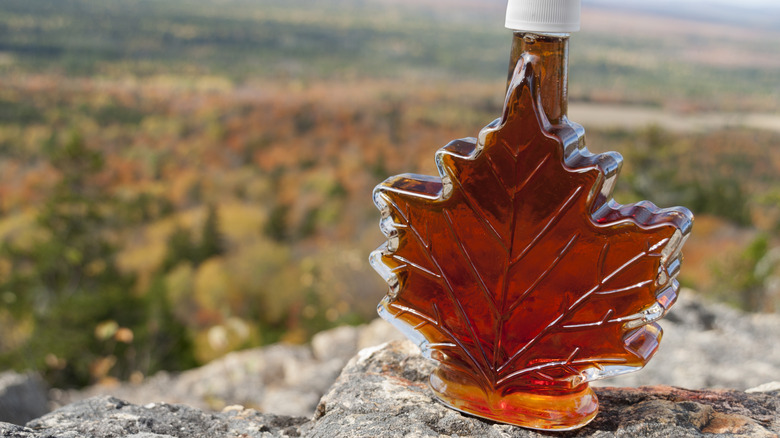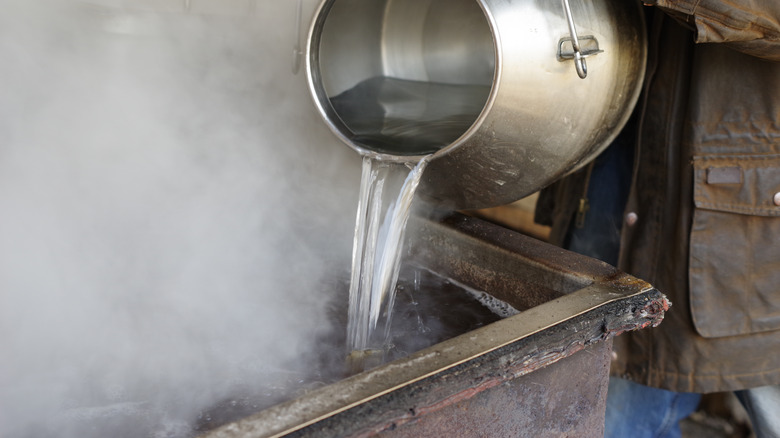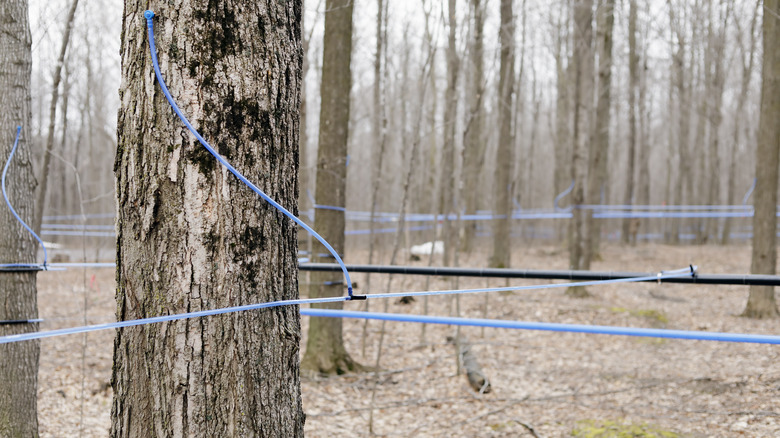The Laborious Reason Maple Syrup Is So Expensive
The taste of real, pure maple syrup can be hard to describe. It's sweet, of course, but so different from other sweeteners like white sugar or honey. Maple syrup has a warm, velvety sweetness; depending on whether the syrup is light and golden or dark amber in color, it can also have hints of wood, caramel, vanilla, coffee, brown sugar, or marshmallow. In some maple syrups, you can even taste a little smokiness imbued by the log fires used to boil the sap.
Maple syrup has a unique, alluring flavor that can't be matched — not even close — by mass-produced pancake toppings that are little more than corn syrup with artificial flavors and colors. That's why Northerners so look forward to the official start of spring: the sugaring season when the sap begins to flow from maple trees and great billows of steam rise from sugarhouses.
So why is it then that people still buy the imitation stuff? Really it mostly comes down to cost, because as delicious as real maple syrup is, it's also more expensive. According to Statista, in 2022, the average price in the United States for maple syrup ranged from $31 to as high as $52 per gallon. However, before you reach for a bottle of cheap pancake syrup to save a few bucks, it's worth understanding just what goes into the making of real maple syrup — and why it's worth the price.
Maple syrup takes a whole lotta sap
Pure maple syrup begins as a clear, watery sap that flows from sugar maple trees. According to Penn State, at this stage only 2% of the sap is made of sugar; the rest is just water, so raw sap tastes only faintly sweet. Vermont Maple Sugar Makers Association explains that to create the syrup, the sap must be boiled for hours to cook off the water and concentrate the sugars. So much of the sap is lost in a sweet-smelling cloud of steam that it takes an incredible forty gallons or more to make just one gallon of maple syrup.
Traditional Maple Farmers, a collective of Vermont maple farms, says a sugar maple tree only produces about 10 gallons of sap in a season, and maple syrup producers must wait until the trees are at least 20 years old before tapping them. That means that anyone wanting to produce enough maple syrup to actually make a business out of it has to own hundreds of established maple trees.
Add to this that the sugaring season is brief and unpredictable: sap will only run with the perfect combination of late-winter, below-freezing nights and mild winter days. Once that happens maple producers are in a race against time: they have about a month to gather as much sap as possible before trees begin to produce leaf buds, at which point the sap becomes too bitter to use.
Time is money, of course, and all this waiting (and all of those trees) adds to the cost of maple syrup, but that doesn't even cover all the work it takes to actually get that sap out of the trees and into production.
The short sugaring season requires intense work
In some ways, gathering sap is much easier today than in the old days, when buckets were hung beneath taps hammered into maple trees to catch the flowing sap. Farmers used sleds or horse-drawn wagons to go from tree to tree gathering the sap. Today it's more common to see an intricate web of plastic tubing threaded through the woods, connected to taps in the trees. The sap flows through the tubes directly to the sugar house.
Despite this innovation, a lot of physical labor still goes into the job. Miles of tubing must be checked regularly and cleared of ice or snow that would weigh them down and disrupt the flow. That means trudging on foot through acres of woods on cold winter days, through snow that can be waist-deep in places, to repair tubing and taps. And because the sap run is so short, maple producers and their teams put in 60 to 80 hours a week during sugaring season, making the most of the time they have.
The short harvesting season, investment in trees, land, and equipment, and physical demands all play a part in the price of real maple syrup. Maple producers are fiercely proud of the syrups they create, so much so that states have laws in place to protect the industry from cheaper products trying to masquerade as real maple. It's more than worth the price you pay for pure maple syrup, for that delectable flavor as well as to support hard-working, small-business maple producers.


